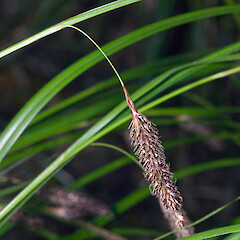Carex solandri
Common name
forest sedge, Solander’s sedge
Synonyms
Carex dissita Boott var. solandri (Boott) Kük.
Family
Cyperaceae
Flora category
Vascular – Native
Endemic taxon
Yes
Endemic genus
No
Endemic family
No
Structural class
Sedges
NVS code
The National Vegetation Survey (NVS) Databank is a physical archive and electronic databank containing records of over 94,000 vegetation survey plots - including data from over 19,000 permanent plots. NVS maintains a standard set of species code abbreviations that correspond to standard scientific plant names from the Ngä Tipu o Aotearoa - New Zealand Plants database.
CARSOL
Current conservation status
The conservation status of all known New Zealand vascular plant taxa at the rank of species and below were reassessed in 2017 using the New Zealand Threat Classification System (NZTCS) – more information about this can be found on the NZTCS website. This report includes a statistical summary and brief notes on changes since 2012 and replaces all previous NZTCS lists for vascular plants.
Please note, threat classifications are often suggested by authors when publications fall between NZTCS assessment periods – an interim threat classification status has not been assessed by the NZTCS panel.
- Conservation status of New Zealand indigenous vascular plants, 2017 . 2018. Peter J. de Lange, Jeremy R. Rolfe, John W. Barkla, Shannel P. Courtney, Paul D. Champion, Leon R. Perrie, Sarah M. Beadel, Kerry A. Ford, Ilse Breitwieser, Ines Schönberger, Rowan Hindmarsh-Walls, Peter B. Heenan and Kate Ladley. Department of Conservation. Source: NZTCS and licensed by DOC for reuse under the Creative Commons Attribution 4.0 International licence.
2017 | Not Threatened
Previous conservation statuses
2012 | Not Threatened
2009 | Not Threatened
2004 | Not Threatened
Distribution
Endemic. North, South and Stewart Islands
Habitat
Coastal to montane. Usually in riparian forest where it may be the dominant sedge of alluvial terraces, and riversides but also colonising wet seepages and slip scars. Usually found in association with C. dissita Boott.
Wetland plant indicator status rating
Information derived from the revised national wetland plant list prepared to assist councils in delineating and monitoring wetlands (Clarkson et al., 2021 Manaaki Whenua – Landcare Research Contract Report LC3975 for Hawke’s Bay Regional Council). The national plant list categorises plants by the extent to which they are found in wetlands and not ‘drylands’. The indicator status ratings are OBL (obligate wetland), FACW (facultative wetland), FAC (facultative), FACU (facultative upland), and UPL (obligate upland). If you have suggestions for the Wetland Indicator Status Rating, please contact: [Enable JavaScript to view protected content]
FAC: Facultative
Commonly occurs as either a hydrophyte or non-hydrophyte (non-wetlands).
Detailed description
Dense yellow-green tufts, upper part of leaves and culms drooping. Culms 0.10–1 m long, c. 1 mm diameter, trigonous, smooth; basal sheaths red-brown, red-purple to black. Leaves < or = culms, 1.5–6.5 mm wide, linear, double-folded, cartilaginous. Inflorescence of 5–10 distant spikes 10–50 mm long, nodding on long filiform peduncles; terminal 1–4 spikes male, slender, usually approximate; remaining spikes female with a few male flowers above or below, 3–4 mm diameter, usually almost black, lowermost spikes often compound; subtending bracts leafy, > inflorescence. Glumes (excluding awn) ± = or < utricles, ovate, lanceolate, entire or rarely emarginate, light or dark brown, membranous, midrib produced to a scabrid awn of varying length. Utricles 2–3 mm long, slightly > 1 mm diameter, plano-convex, unequally biconvex or subtrigonous, fusiform or ovoid, turgid, dark red-brown to almost black, occasionally light brown, pale yellow towards the base, surface smooth, occasionally faintly nerved at the base, shining; scarcely narrowed above to a bidentate beak < 0.5 mm. long, margins smooth or occasionally scabrid, orifice us. scabrid; rarely contracted to a stipe c. 0.2 mm. long. Stigmas 3. Nut c. 1 mm. long, trigonous, obovoid, cream, surface minutely but deeply pitted giving angles of nut a serrate appearance.
Similar taxa
Carex solandri is most often confused with C. dissita Boott, especially as both species often grow together. Carex dissita differs from C. solandri by the distant, dark brown, rather short and stout, usually shortly pedunculate female spikes. Further, the utricles are also distinctly bicoloured basally cream to yellow brown and red-purple to black above. C. solandri has long filiform peduncles and uniformly dark coloured utricles (rarely light brown and pale yellow near the base).
Flowering
August–December
Fruiting
October–May
Life cycle
Nuts surrounded by inflated utricles are dispersed by granivory and wind (Thorsen et al., 2009).
Propagation technique
Easily grown from fresh seed and by division of established plants. A popular species in cultivation, and often sold incorrectly as C. dissita. Prefers a permanently damp, semi-shaded site but once established can tolerate full sun and dry spells.
Etymology
carex: Latin name for a species of sedge, now applied to the whole group.
solandri: Named after Daniel Carlsson Solander (19 February 1733 - 13 May 1782) who was a Swedish naturalist and an apostle of Carl Linnaeus.
Attribution
Fact Sheet prepared by P.J. de Lange (10 August 2006). Description adapted from Moore and Edgar (1970)
References and further reading
Moore LB, Edgar E. 1970. Flora of New Zealand, Volume II. Indigenous Tracheophyta: Monocotyledones except Gramineae. Government Printer, Wellington, NZ. 354 p.
Thorsen MJ, Dickinson KJM, Seddon PJ. 2009. Seed dispersal systems in the New Zealand flora. Perspectives in Plant Ecology, Evolution and Systematics 11: 285–309.
NZPCN Fact Sheet citation
Please cite as: de Lange, P.J. (Year at time of access): Carex solandri Fact Sheet (content continuously updated). New Zealand Plant Conservation Network. https://www.nzpcn.org.nz/flora/species/carex-solandri/ (Date website was queried)
















